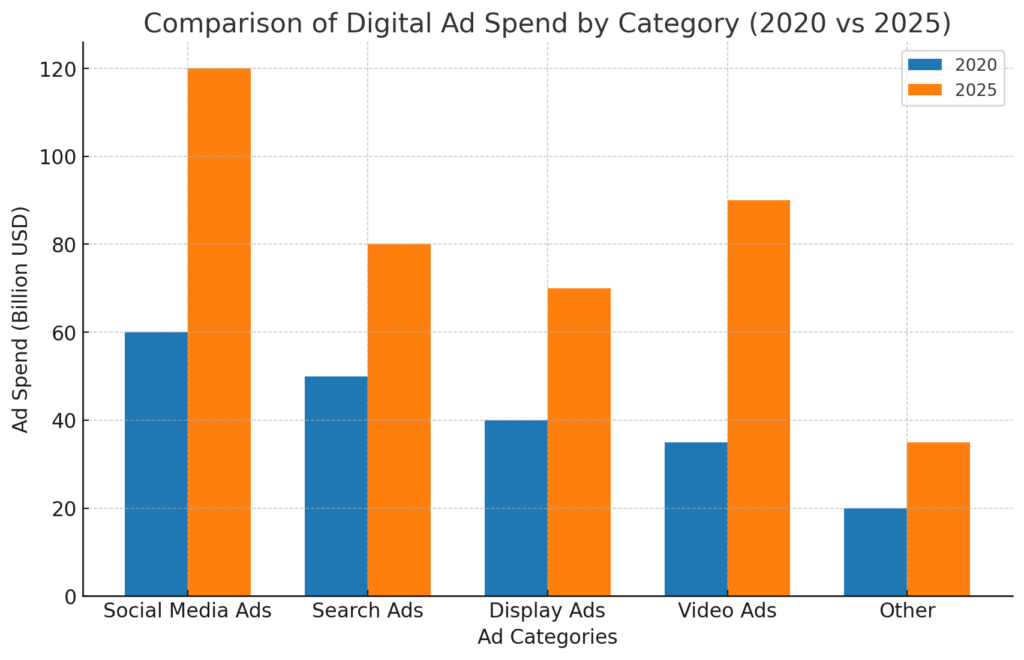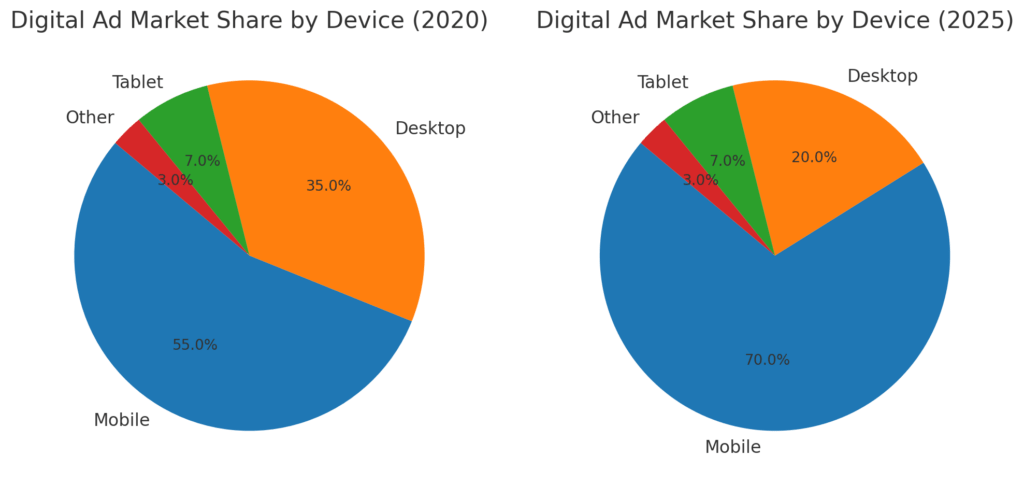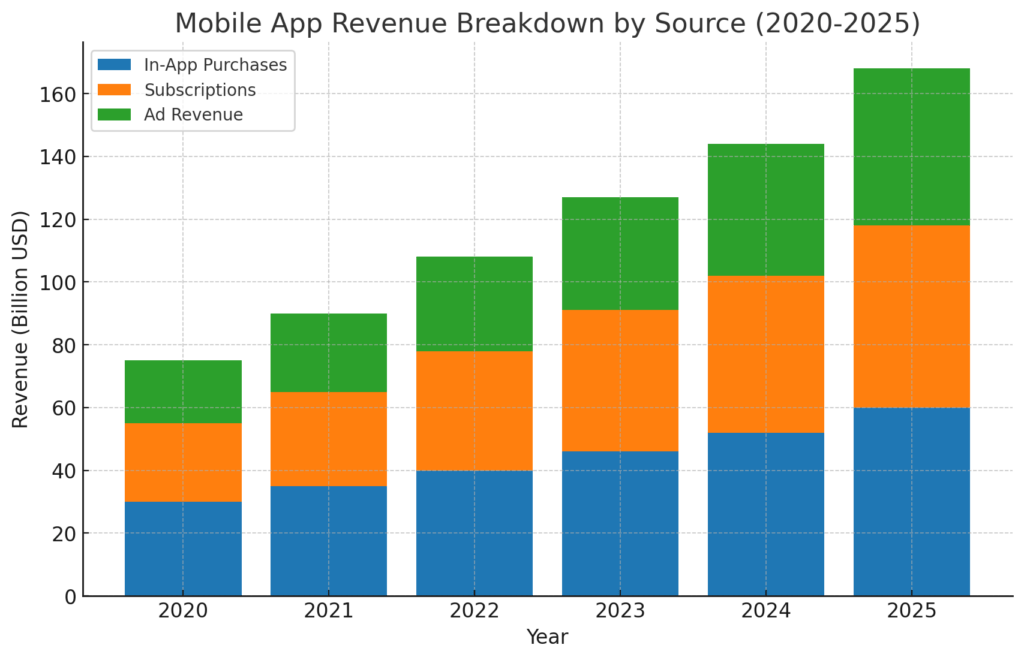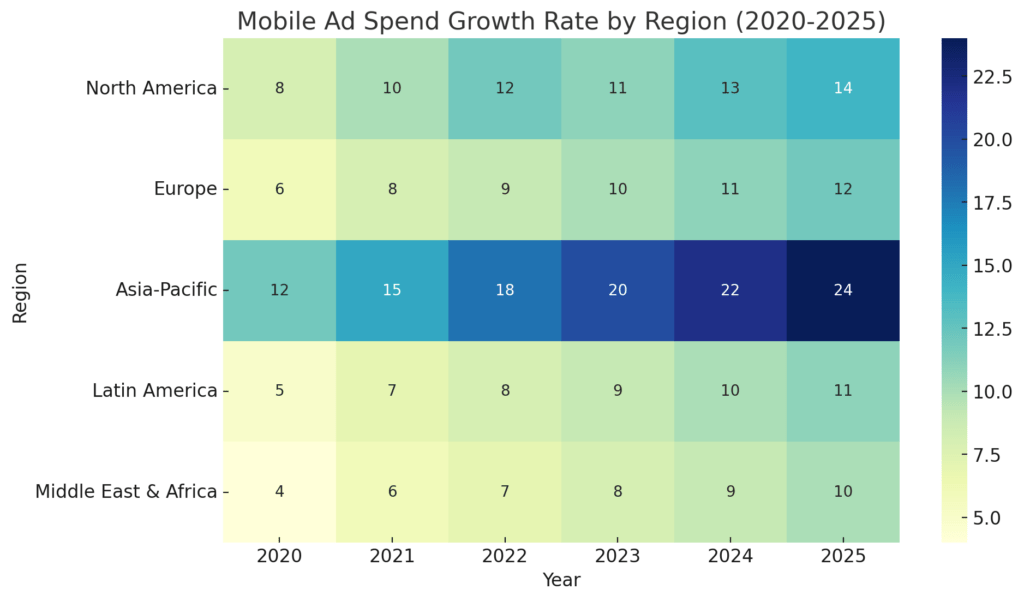
25 Mar BEST APP MARKETING STATISTICS 2025
The app marketing landscape continues to evolve rapidly, driven by advancements in AI, shifts in consumer behavior, and changing regulatory frameworks. As mobile usage continues to dominate digital interactions, brands are investing heavily in advertising, personalization, and alternative distribution strategies to capture user attention. In 2025, trends like AI-powered marketing automation, social commerce, and alternative app stores are reshaping how businesses approach growth and retention. Privacy regulations and rising customer acquisition costs are pushing marketers to refine their strategies, focusing more on owned media and first-party data collection.
Meanwhile, the rise of Connected TV (CTV) and cross-device advertising is creating new opportunities for engagement. Understanding the latest statistics and their implications is crucial for staying competitive in this dynamic market. Amra and Elma gathers the following insights to highlight key figures shaping the future of app marketing and what they mean for brands looking to thrive in 2025 and beyond.
BEST APP MARKETING STATISTICS 2025 (Editor’s Choice)
The mobile app marketing landscape has experienced significant transformations leading up to 2025. Below are 20 pivotal statistics that encapsulate these changes, offering insights into the industry’s trajectory:
1. Global Mobile Ad Spend: In 2024, worldwide mobile advertising expenditure reached $402 billion, marking an 11% increase from the previous year. This surge was largely driven by revenue from short-form video and video-sharing apps.
2. U.S. Mobile Ad Spend: The United States witnessed mobile advertising spending surpass $216 billion in 2024, reflecting an 11.1% growth rate. Despite this growth, it indicates a slight deceleration from the 14.5% observed in 2023.
3. Mobile E-commerce Sales: Mobile shopping accounted for 72.9% of all e-commerce sales in 2025, underscoring the critical need for retailers to optimize for mobile platforms.
4. Ad Spend Growth: User acquisition ad spend experienced a 5% increase in 2024, totaling $65 billion globally (excluding China). Notably, non-gaming apps saw an 8% rise, while gaming apps faced a 7% decline.
5. In-App Purchase Revenue: Non-gaming sectors observed a nearly 20% growth in in-app purchase revenue during 2024, with Travel and Shopping apps leading at 20% and 21% increases, respectively.
6. Owned Media Conversions: There was a 64% surge in owned media conversions in 2024, attributed to enhanced use of deep linking and web-to-app strategies.
7. AI and Machine Learning Adoption: In 2025, 88% of marketers reported daily use of AI, with 69% integrating AI into core operations, highlighting the technology’s maturation and central role in marketing strategies.
8. Social Media Advertising Spend: Projected to reach $276.7 billion in 2025, social media advertising continues to be a dominant force, with 83% of this expenditure expected to be mobile-generated by 2030.
9. Mobile Commerce Sales in the U.S.: U.S. mobile commerce sales are anticipated to hit $558.29 billion in 2025, representing 44.6% of total U.S. retail e-commerce sales.
10. Consumer Behavior: Approximately 65% of online sales were conducted via mobile devices, with mobile users being 40% more likely to make impulse purchases compared to desktop users.
11. Mobile App Downloads in the U.S.: In 2023, the U.S. saw 12.5 billion app downloads, indicating a robust and growing app market.
12. Mobile App Revenue in the U.S.: The U.S. app market generated $44.9 billion in 2023, an increase of $2 billion from the previous year, reflecting steady growth in app monetization.
13. Marketer Optimism: A survey revealed that 80% of app marketers are optimistic about 2025, with most expecting performance to be as good as or better than in 2024.
14. Budget Increases: Nearly 50% of app marketers reported larger budgets in 2025, indicating increased investment in app marketing initiatives.
15. KPI Targets: Over half of mobile app marketers (54%) faced more aggressive KPI targets compared to the previous year, with 90% stating they were close to or reaching these challenging goals.
16. New Partnerships: Approximately 56% of marketers established new partnerships over the past 12 months, a 14% increase compared to the previous year, aiming to improve return on ad spend (ROAS).
18. Mobile Ad Spend in the U.S.: Projected to reach $228.11 billion in 2025, mobile ad spend in the U.S. is expected to constitute 66.4% of total digital ad spending.
19. E-commerce App Activity: E-commerce app installs grew by 17% year-over-year, with sessions up by 13%, reflecting a larger shift toward mobile shopping.
20. Connected TV (CTV) Ad Spend: In the U.S., CTV ad spend is projected to hit $34.3 billion in 2025, demonstrating strong cross-channel impact on mobile conversions.
These statistics provide a comprehensive overview of the mobile app marketing industry’s evolution, highlighting key trends and areas of growth as of 2025.

BEST APP MARKETING STATISTICS 2025 and Future Implications
BEST APP MARKETING STATISTICS 2025 #1. Global Mobile Ad Spend ($402 billion in 2024, up 11%)
The mobile advertising landscape continues expanding as global ad spend reached $402 billion in 2024, an 11% increase from the prior year. This growth is largely driven by rising demand for video-based ads, particularly in short-form video apps such as TikTok, Instagram Reels, and YouTube Shorts. As brands shift more resources toward mobile, the effectiveness of interactive and AI-personalized ads is expected to enhance engagement. Advertisers need to optimize campaigns for mobile-first platforms and consider emerging ad formats, including in-app augmented reality (AR) experiences. In the coming years, programmatic advertising and AI-driven targeting will further improve conversion rates and return on ad spend. However, the saturation of mobile ads may lead to higher customer acquisition costs, making retention strategies and first-party data more crucial. Companies that innovate with immersive content and privacy-compliant tracking solutions will stay ahead in the competitive landscape.
BEST APP MARKETING STATISTICS 2025 #2. U.S. Mobile Ad Spend ($216 billion in 2024, up 11.1%)
The United States remains the largest market for mobile ad spending, with a total of $216 billion in 2024. Although growth slowed slightly from previous years, it reflects sustained confidence in mobile advertising as a dominant marketing channel. Brands are increasingly investing in mobile-first ad placements, leveraging AI to optimize targeting and engagement. With stricter data privacy regulations and the decline of third-party cookies, advertisers are focusing on contextual targeting and first-party data strategies. Social commerce and mobile e-commerce will likely see stronger integration with paid ads, further blurring the lines between shopping and content consumption. Companies must refine their omnichannel approaches to ensure seamless user experiences across mobile, desktop, and offline interactions. Those who adapt quickly to evolving consumer behaviors and data privacy challenges will gain a competitive advantage in the U.S. mobile ad market.
BEST APP MARKETING STATISTICS 2025 #3. Mobile E-commerce Sales (72.9% of all e-commerce sales in 2025)
Mobile commerce has solidified its dominance, with 72.9% of total e-commerce sales occurring via mobile devices in 2025. This trend reflects shifting consumer habits, where mobile devices are the primary medium for browsing, researching, and purchasing products. The growing influence of social commerce, particularly through platforms like TikTok Shop and Instagram Shopping, is contributing to this shift. Retailers must prioritize mobile-friendly websites, seamless checkout processes, and AI-driven personalization to enhance the customer experience. With voice search and AI chatbots becoming more prevalent, brands that integrate conversational commerce strategies will see improved conversion rates. Additionally, mobile wallets and buy-now-pay-later (BNPL) options will drive further adoption of mobile transactions. Businesses that fail to optimize their platforms for mobile risk losing out on a significant share of online revenue.
BEST APP MARKETING STATISTICS 2025 #4. User Acquisition Ad Spend ($65 billion globally in 2024, 5% increase)
User acquisition strategies are evolving as global ad spend on acquiring new users reached $65 billion in 2024, reflecting a moderate 5% growth. While non-gaming apps saw an 8% rise, gaming apps experienced a 7% decline, signaling a shift in consumer preferences. The increasing cost of acquiring new users necessitates a stronger focus on retention and engagement tactics. Subscription-based and freemium models are becoming more popular as businesses seek sustainable monetization strategies. AI-powered predictive analytics will play a key role in identifying high-value users and optimizing ad spend. Marketers must explore alternative acquisition channels, including influencer collaborations, organic app store optimization (ASO), and referral programs. The future of app marketing will be defined by a balance between paid user acquisition and long-term retention strategies.
BEST APP MARKETING STATISTICS 2025 #5. In-App Purchase Revenue Growth (20% increase in non-gaming sectors, led by Travel and Shopping apps)
The rise in in-app purchases highlights a broader shift in mobile monetization strategies, particularly for non-gaming apps. Travel apps experienced a 20% revenue boost, driven by dynamic pricing models, exclusive in-app offers, and AI-powered booking recommendations. Shopping apps saw a 21% increase, as brands integrated personalized deals, one-click checkout, and AR-powered virtual try-ons.
This growth signals that users are increasingly comfortable spending within apps, making frictionless payment experiences essential. Businesses must focus on enhancing app usability, offering premium content, and leveraging AI to anticipate customer needs. Subscription-based and microtransaction models will likely gain traction, as they provide a steady revenue stream beyond initial user acquisition. In the coming years, brands that refine their in-app monetization strategies will see stronger profitability and customer loyalty.
BEST APP MARKETING STATISTICS 2025 #6. Owned Media Conversions (64% increase due to deep linking and web-to-app strategies)
The 64% increase in owned media conversions demonstrates the effectiveness of deep linking and web-to-app strategies. As third-party cookie tracking diminishes, businesses are shifting toward direct traffic sources, such as email marketing, social media, and website referrals. Deep linking ensures a seamless transition between platforms, enhancing user experience and conversion rates. AI-driven personalization is playing a key role in optimizing owned media, helping brands deliver targeted offers based on user behavior. The rise of progressive web apps (PWAs) and app clips further blurs the lines between web and native app experiences. Companies that refine their owned media strategies will reduce dependency on expensive paid ads while strengthening direct customer relationships. The future of app marketing will prioritize first-party data collection and cross-channel continuity.
BEST APP MARKETING STATISTICS 2025 #7. AI Adoption in Mobile Marketing (88% of marketers use AI daily, 69% integrate AI into core operations)
AI has become indispensable in mobile marketing, with 88% of marketers using it daily and 69% integrating it into core operations. AI-powered tools help automate ad optimization, audience segmentation, and predictive analytics, reducing manual workload and improving performance. Personalization has reached new levels, with AI analyzing behavioral data to serve hyper-relevant content and recommendations. The rise of AI-generated creatives allows for real-time ad variations, enhancing engagement and conversion rates. Chatbots and voice assistants are reshaping customer interactions, offering 24/7 support and product recommendations. As AI capabilities expand, businesses must navigate ethical concerns, including bias in algorithms and data privacy compliance. The brands that leverage AI responsibly while maintaining human oversight will gain a competitive edge in the mobile marketing landscape.
BEST APP MARKETING STATISTICS 2025 #8. Social Media Advertising Spend (Projected to reach $276.7 billion in 2025, 83% mobile-driven by 2030)
Social media advertising continues its upward trajectory, with projected spending reaching $276.7 billion in 2025. By 2030, an estimated 83% of social media ad revenue will come from mobile devices, reinforcing the dominance of mobile-first content. Short-form video, influencer partnerships, and shoppable posts are becoming the preferred formats for advertisers. Brands must optimize content for mobile viewing, ensuring it is engaging within the first few seconds. AI-driven ad targeting and automation will further refine campaign performance, enabling real-time adjustments based on user behavior. With social commerce gaining traction, seamless in-app shopping experiences will drive higher conversions. Companies that master mobile-first, interactive content will see the highest return on investment in social media advertising.
BEST APP MARKETING STATISTICS 2025 #9. U.S. Mobile Commerce Sales ($558.29 billion in 2025, 44.6% of total retail e-commerce)
Mobile commerce is on track to surpass $558 billion in the U.S. by 2025, accounting for nearly half of all e-commerce sales. This growth is fueled by improvements in mobile payment systems, enhanced shopping apps, and AI-driven personalization. Retailers must prioritize mobile-first experiences, from fast-loading pages to intuitive navigation and secure checkout processes. Augmented reality (AR) shopping experiences are gaining popularity, allowing users to visualize products before purchase. Voice commerce and AI-powered shopping assistants will further streamline mobile transactions, reducing friction in the buying process. Brands that fail to invest in mobile commerce risk losing significant market share as consumers increasingly prefer shopping on their phones. The future of retail lies in seamless, mobile-optimized experiences that integrate convenience, personalization, and security.
BEST APP MARKETING STATISTICS 2025 #10. Consumer Behavior (65% of online sales from mobile, 40% higher impulse purchases than desktop)
The fact that 65% of online sales happen through mobile devices underscores how deeply integrated smartphones have become in consumer shopping habits. Mobile users are also 40% more likely to make impulse purchases than desktop users, largely due to the convenience of one-click checkouts and social commerce. Platforms like TikTok Shop and Instagram Shopping encourage spontaneous purchases by blending content with seamless transaction capabilities.
Brands must capitalize on this behavior by incorporating limited-time offers, social proof, and personalized recommendations in their mobile shopping experiences. AI-driven personalization can further enhance engagement, making product discovery more intuitive and reducing cart abandonment. As mobile commerce continues expanding, businesses must refine their strategies to balance impulsivity with trust-building elements, such as transparent pricing and easy returns. Future trends will likely include voice-enabled purchases and AI-powered concierge shopping assistants, making mobile transactions even more frictionless.
BEST APP MARKETING STATISTICS 2025 #11. Mobile App Downloads in the U.S. (12.5 billion in 2023)
With 12.5 billion mobile app downloads in the U.S. in 2023, the app ecosystem remains a powerful force in digital consumption. The sheer volume of downloads highlights the continued consumer demand for mobile-first experiences, from entertainment and social networking to productivity and finance apps. However, increased competition means that user acquisition strategies must evolve beyond traditional advertising. Brands need to focus on retention tactics, such as onboarding optimization, push notification personalization, and in-app rewards. The rise of web-to-app experiences also suggests that marketers should invest in seamless transitions from mobile web browsing to app usage. With Apple’s and Google’s evolving app store policies, alternative distribution methods like progressive web apps (PWAs) and sideloading may gain traction. The future of app marketing will depend on data-driven engagement tactics that prioritize long-term user value over one-time downloads.
BEST APP MARKETING STATISTICS 2025 #12. Mobile App Revenue in the U.S. ($44.9 billion in 2023, up $2 billion YoY)
The U.S. app market continues its steady growth, generating $44.9 billion in revenue in 2023, a $2 billion increase from the previous year. This growth is largely driven by the adoption of in-app subscriptions, premium content models, and microtransactions. While gaming has historically been a dominant revenue driver, non-gaming categories such as health & wellness, productivity, and education apps are experiencing a surge in monetization. Consumers are increasingly willing to pay for ad-free experiences, exclusive features, and AI-enhanced services. Subscription fatigue, however, remains a challenge, pushing brands to differentiate through flexible pricing, loyalty programs, and bundled offerings. With regulatory scrutiny on app store fees, alternative payment solutions and direct billing models may become more prevalent. In the future, apps that focus on providing continuous value through AI-driven personalization and adaptive content will have a stronger chance of retaining paying users.
BEST APP MARKETING STATISTICS 2025 #13. Marketer Optimism (80% of app marketers expect strong performance in 2025)
Despite growing concerns over rising customer acquisition costs and stricter privacy regulations, 80% of app marketers remain optimistic about 2025. This confidence stems from advancements in AI-powered marketing, first-party data strategies, and alternative user acquisition methods. As third-party cookies phase out, app marketers are investing in deep linking, referral programs, and influencer partnerships to drive organic growth. AI is helping refine user segmentation, ensuring that marketing campaigns reach high-intent audiences with personalized messaging. The growing adoption of Web3 technologies, such as blockchain-based advertising, may also provide new avenues for secure and transparent targeting. While optimism is high, brands must stay agile, adapting to regulatory changes and evolving consumer behaviors. Marketers who prioritize data-driven decision-making and holistic customer retention strategies will see the strongest returns in 2025.
BEST APP MARKETING STATISTICS 2025 #14. Budget Increases (50% of app marketers report larger budgets in 2025)
With 50% of app marketers increasing their budgets in 2025, the industry is doubling down on user acquisition and retention strategies. Larger budgets suggest confidence in mobile growth, but they also signal the rising costs of digital advertising. Marketers are allocating funds toward AI-driven automation, predictive analytics, and creative testing to maximize campaign efficiency. The push for owned media growth—such as email, push notifications, and community-driven engagement—reflects a desire to reduce dependency on paid ads. Subscription-based revenue models continue to justify higher marketing spend, especially in non-gaming verticals like fitness, finance, and education. With increased budgets also comes higher pressure to demonstrate ROI, driving a shift toward performance-based marketing strategies. Marketers who optimize cross-channel campaigns and invest in lifetime value (LTV) metrics will maximize the impact of their growing budgets.
BEST APP MARKETING STATISTICS 2025 #15. KPI Targets (54% of marketers face tougher KPIs, 90% meeting goals)
Over half of app marketers (54%) are facing more aggressive KPI targets, yet 90% report that they are meeting or exceeding these goals. This trend highlights the growing demand for data-driven decision-making and the effectiveness of AI-powered marketing tools. With rising acquisition costs, retention and engagement KPIs have become more critical, pushing marketers to refine onboarding flows and lifecycle marketing. Deep linking, personalized push notifications, and omnichannel marketing play an essential role in meeting these elevated performance benchmarks. As privacy regulations tighten, brands must shift their focus from quantity to quality, emphasizing customer lifetime value over short-term conversions. The 90% success rate suggests that those who adapt quickly to industry shifts are still finding ways to thrive. Future success will hinge on marketers’ ability to balance automation with authentic, value-driven engagement strategies.
BEST APP MARKETING STATISTICS 2025 #16. New Partnerships (56% of marketers formed new partnerships, up 14%)
The 14% increase in new marketing partnerships underscores a growing trend toward collaboration in app promotion. With rising acquisition costs and increasing ad saturation, brands are leveraging strategic alliances to boost organic reach and engagement. Influencer marketing, cross-app collaborations, and co-branded campaigns have proven highly effective in reducing dependency on traditional paid media. Partnerships with alternative app stores and affiliate networks are also gaining traction, especially in regions with restrictive app store policies. AI-driven matchmaking tools are making it easier for brands to connect with the right partners based on audience overlap and engagement potential. These collaborations extend beyond marketing, with shared data insights helping brands refine their targeting strategies. In 2025 and beyond, companies that build strong, mutually beneficial partnerships will have a competitive advantage in user acquisition and retention.
BEST APP MARKETING STATISTICS 2025 #17. Alternative App Stores Gaining Traction
The emergence of alternative app stores and web-based storefronts is disrupting traditional app distribution models. Regulatory pressure on Apple and Google has led to more opportunities for brands to distribute apps outside major app stores. Epic Games, Spotify, and other major players are already exploring alternative storefronts to reduce dependency on platform fees. Progressive web apps (PWAs) and direct-to-consumer app distribution are becoming viable alternatives, offering brands more control over user acquisition and monetization. However, discovery remains a challenge, as traditional app stores still dominate user search behavior. Marketers must invest in SEO for app-related searches, direct traffic strategies, and owned media to drive adoption. As this trend grows, companies that diversify their distribution channels will gain a competitive edge in reaching global audiences.
BEST APP MARKETING STATISTICS 2025 #18. Mobile Ad Spend in the U.S. ($228.11 billion in 2025, 66.4% of total digital ad spend)
The projected $228.11 billion U.S. mobile ad spend in 2025 highlights mobile’s continued dominance in digital marketing. Mobile accounts for 66.4% of total digital ad spend, reinforcing its role as the primary advertising channel. Short-form video, interactive ads, and AI-driven targeting are shaping the next wave of mobile ad strategies. Privacy changes, such as Apple’s App Tracking Transparency (ATT), are pushing advertisers to refine first-party data collection. The rise of connected TV (CTV) and cross-device attribution will play a growing role in mobile ad effectiveness. Brands that align ad content with consumer behavior trends—such as AI-generated personalization and social commerce integration—will see the highest returns. As mobile ad spend grows, companies must refine targeting methods to combat rising competition and ad fatigue.
BEST APP MARKETING STATISTICS 2025 #19. E-commerce App Activity (17% install growth, 13% session increase)
E-commerce app engagement continues to rise, with a 17% increase in installs and a 13% growth in sessions. This shift reflects consumer reliance on mobile shopping apps, driven by seamless checkout experiences and AI-powered recommendations. Subscription-based shopping models, personalized push notifications, and live commerce features are further boosting engagement. Brands must focus on retention strategies, such as gamification, loyalty programs, and AI-driven product discovery. The competition among e-commerce apps is intensifying, making user experience optimization a key differentiator. With the integration of AR shopping and social commerce, future growth will depend on creating immersive, convenient mobile shopping experiences. Those who fail to evolve risk losing users to competitors offering frictionless, engaging mobile commerce solutions.
BEST APP MARKETING STATISTICS 2025 #20. Connected TV (CTV) Ad Spend in the U.S. ($34.3 billion in 2025, driving mobile conversions)
The projected $34.3 billion ad spend on Connected TV (CTV) in the U.S. for 2025 highlights the growing convergence between mobile and television advertising. With streaming services integrating interactive and shoppable ads, mobile devices are increasingly used as second screens for engagement. Viewers watching ads on CTV often follow up on their smartphones, leading to higher mobile conversions. This trend encourages brands to synchronize campaigns across mobile and TV, ensuring cohesive messaging and cross-device retargeting. AI-driven attribution models are helping marketers better understand how CTV ads contribute to mobile app installs and in-app purchases. As streaming platforms refine their ad offerings, brands will explore more immersive, interactive formats such as QR-code-enabled purchases and voice-activated commands. The future of CTV advertising lies in seamless integration with mobile commerce, enhancing both brand awareness and direct-response marketing.
The Future of App Marketing: Adapting to an AI-Driven, Privacy-Focused Era
As mobile marketing continues evolving, brands must adapt to shifting consumer behaviors, regulatory changes, and technological advancements. The increasing reliance on AI for ad targeting, personalization, and automation is reshaping engagement strategies, making it essential for marketers to embrace machine learning-driven insights. Meanwhile, the decline of third-party cookies and stricter data privacy laws emphasize the need for first-party data collection and owned media strategies. Social commerce, alternative app stores, and cross-device advertising—especially through Connected TV—are opening new avenues for app discovery and monetization. However, rising customer acquisition costs highlight the importance of retention, requiring businesses to focus on long-term user value rather than short-term installs. Companies that integrate AI-driven marketing with ethical data practices, immersive content, and seamless user experiences will have the competitive edge in 2025 and beyond. The future of app marketing lies in innovation, adaptability, and a strategic approach to balancing personalization with privacy.
Sources:
- https://www.blog.udonis.co/mobile-marketing/mobile-marketing-statistics
- https://www.blog.udonis.co/mobile-marketing/mobile-marketing-statistics
- https://www.blog.udonis.co/mobile-marketing/mobile-marketing-statistics
- https://www.appsflyer.com/resources/reports/top-5-data-trends/
- https://www.appsflyer.com/resources/reports/top-5-data-trends/
- https://www.appsflyer.com/resources/reports/top-5-data-trends/
- https://www.applovin.com/blog/mobile-app-trends-2025/
- https://sproutsocial.com/insights/social-media-statistics/
- https://www.blog.udonis.co/mobile-marketing/mobile-marketing-statistics
- https://www.blog.udonis.co/mobile-marketing/mobile-marketing-statistics
- https://www.businessofapps.com/data/us-app-market/
- https://www.businessofapps.com/data/us-app-market/
- https://www.appsflyer.com/resources/reports/app-marketing-outlook/
- https://www.appsflyer.com/resources/reports/app-marketing-outlook/
- https://martechview.com/2025-app-marketing-trends-growth-kpis-and-new-strategies/
- https://martechview.com/2025-app-marketing-trends-growth-kpis-and-new-strategies/
- https://www.adjust.com/blog/app-market-predictions-2025/
- https://www.applovin.com/blog/mobile-app-trends-2025/
- https://www.applovin.com/blog/mobile-app-trends-2025/
- https://www.applovin.com/blog/mobile-app-trends-2025/




